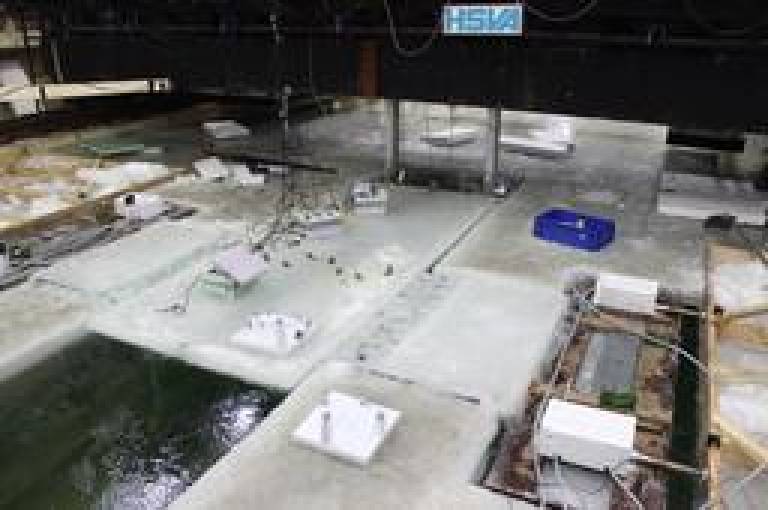Sea Ice Experiments at Hamburg Ship Model Basin (HSVA)
30 July 2017
Field-scale laboratory experiments on artificially grown sea ice were undertaken in May 2017 by an international team of researchers at Hamburg Ship Model Basin (HSVA).
 The project was organised by IRDR PhD students Sally Scourfield and Mark Shortt, and IRDR Director Prof. Peter Sammonds. The experiments conducted were designed to investigate the effects of ice rubble angularity on friction, and also the consolidation rate and strength of rafted sea ice. The rapid decline of sea ice extent in the Arctic brings with it the prospect of increased shipping in the region, as speculation rises that routes through the Northwest and Northeast passages might become commercially viable in the near future. However with this increased activity comes greater exposure to the problems and hazards associated with the interactions between ships and sea ice. Ice rubble accumulations around ports and in frequently used channels through sea ice cover can provide substantial resistance and sometimes prevent transit entirely. Similarly, the rubble generated when ice floes interact with fixed structures can exert large forces on them, which can become hazardous if not properly managed. Experiments at HSVA will contribute to research that helps address these issues and in doing so make the Arctic a safer and more accessible environment for industrial activity.
The project was organised by IRDR PhD students Sally Scourfield and Mark Shortt, and IRDR Director Prof. Peter Sammonds. The experiments conducted were designed to investigate the effects of ice rubble angularity on friction, and also the consolidation rate and strength of rafted sea ice. The rapid decline of sea ice extent in the Arctic brings with it the prospect of increased shipping in the region, as speculation rises that routes through the Northwest and Northeast passages might become commercially viable in the near future. However with this increased activity comes greater exposure to the problems and hazards associated with the interactions between ships and sea ice. Ice rubble accumulations around ports and in frequently used channels through sea ice cover can provide substantial resistance and sometimes prevent transit entirely. Similarly, the rubble generated when ice floes interact with fixed structures can exert large forces on them, which can become hazardous if not properly managed. Experiments at HSVA will contribute to research that helps address these issues and in doing so make the Arctic a safer and more accessible environment for industrial activity.
Friction experiments which were conducted in the Large Ice Model Basin (LIMB) were double-direct shear in nature and involved pushing a mobile, floating ice block that was bound on two sides by regions of ice rubble and subject to a normal force. Tests explored kinetic friction and the memory effects of friction. The latter involved recording the force required to reinitiate movement of the middle block after a certain "hold time", a period ranging from 1 second to 3 hours where the floating block was held motionless. These tests were repeated with four different types of ice rubble - two sizes each of cylindrical ice disks, and diamond shaped ice pieces.
Thank you to the team members who participated in the project and were integral to its success: Ben Lishman (London South Bank University), Kaj Riska (Total), Eleanor Bailey (C-CORE, Canada), Aleksey Marchenko (UNIS, Svalbard) and Sammie Buzzard (CPOM, UCL). A huge thanks also to the ice tank crew at HSVA for their hospitality, technical and scientific support and the professional execution of the test programme in the Research Infrastructure ARCTECLAB. The work described here was supported by the European Community's Horizon2020 Research and Innovation Programme through the grant to HYDRALAB-PLUS, Contract no. 654110.
For more information on Hydralab+ projects and facilities: www.hydralab.eu/ Relevant publications: Scourfield, S., Sammonds, P., Lishman, B. and Marchenko, A., 2015. The effect of ice rubble on ice-ice sliding.
 Close
Close






